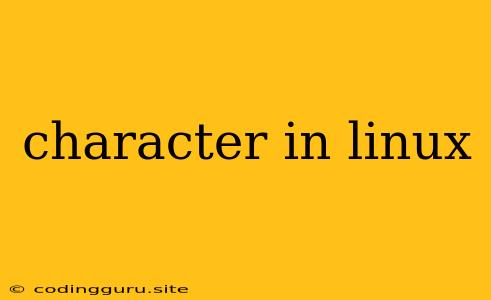Understanding Characters in Linux: A Comprehensive Guide
Linux, renowned for its versatility and power, relies heavily on characters for various operations. From navigating the file system to interacting with commands, characters play a crucial role in the Linux environment. Understanding how characters are handled and represented in Linux is essential for efficient and effective command-line use.
What are characters in Linux?
In the simplest terms, characters are the fundamental building blocks of text in Linux. Each character represents a single symbol, letter, number, or punctuation mark. They are the core components of files, commands, and user input.
Character Encoding: The Key to Interpretation
Linux, like any operating system, needs a way to translate characters into a format that the computer can understand. This process is called character encoding. The most common encoding used in Linux is UTF-8. This standard allows for the representation of a wide range of characters from different languages, making Linux a truly international operating system.
ASCII: The Foundation of Character Representation
ASCII (American Standard Code for Information Interchange) is a foundational character encoding scheme used in computing. It assigns unique numerical values to 128 characters, including uppercase and lowercase letters, numbers, punctuation marks, and control characters.
Beyond ASCII: Extended Character Sets
While ASCII is a good starting point, it doesn't cover the vast array of characters used in languages worldwide. Extended character sets like ISO-8859-1 (Latin-1) and UTF-8 provide more comprehensive mappings, allowing for the representation of characters from various languages, including those with accents, diacritics, and special symbols.
Working with Characters in Linux
Understanding characters is vital for various Linux tasks. Here are some common scenarios:
- File Names: File names can contain various characters, including letters, numbers, underscores, hyphens, and even some special symbols. However, it's generally good practice to avoid using characters that might conflict with system commands or cause issues with certain applications.
- Command Input: When interacting with the command line, every character you type is interpreted by the shell. A single typo can lead to unexpected results or errors. Understanding the significance of each character is critical for accurate command execution.
- Text Editing: Text editors like vim and nano rely heavily on character handling. These editors allow you to manipulate individual characters, lines, and entire files, enabling the creation and modification of text documents.
- Regular Expressions: Regular expressions are powerful tools for pattern matching in text. They use special characters to define patterns, making it possible to search, replace, and manipulate text based on specific criteria.
Tips for Effective Character Handling
- Use the Right Encoding: Ensure that your files and terminal settings are using a compatible encoding. Using UTF-8 is highly recommended for most modern Linux systems.
- Avoid Special Characters in File Names: While some special characters can be used in file names, it's generally better to avoid them to prevent potential issues. Stick to letters, numbers, underscores, and hyphens for consistency.
- Be Mindful of Character Case Sensitivity: Linux is case-sensitive, meaning that "file.txt" is different from "File.txt." Pay close attention to character case when working with commands and files.
- Utilize Escape Sequences: Escape sequences are special combinations of characters that represent specific actions. For example, the escape sequence
\nrepresents a newline character, while\trepresents a tab character. - Explore Character Handling Tools: Linux offers various utilities for character handling, such as iconv, recode, and charset. These tools allow you to convert between different character encodings, analyze character sets, and perform other character-related tasks.
Conclusion
Characters are the foundation of text in Linux. Understanding character encoding, common character sets, and effective handling practices is crucial for smooth and efficient interaction with the Linux environment. By mastering the intricacies of characters, you can navigate the Linux command line with confidence, manipulate files effectively, and utilize the full potential of this powerful operating system.
